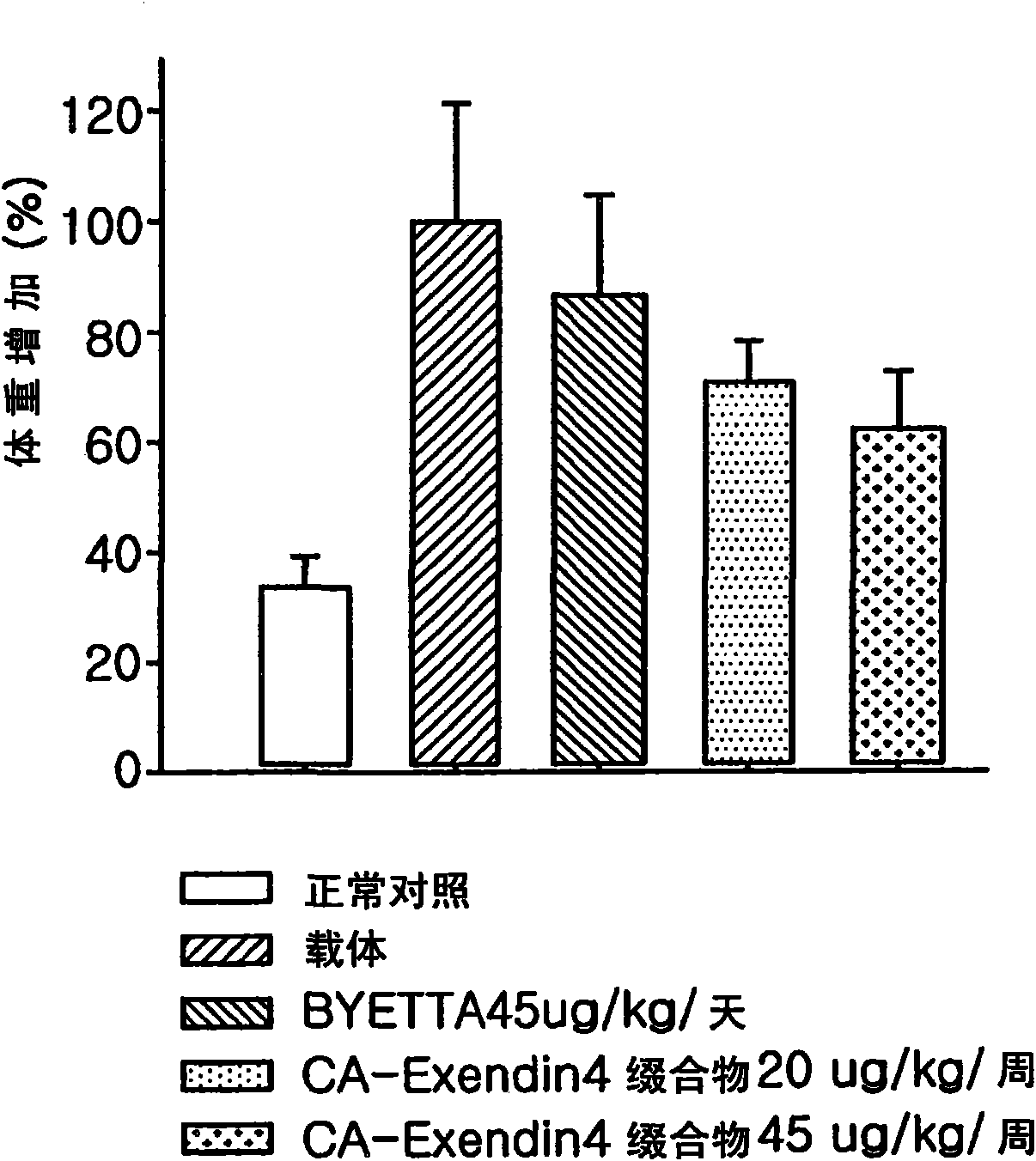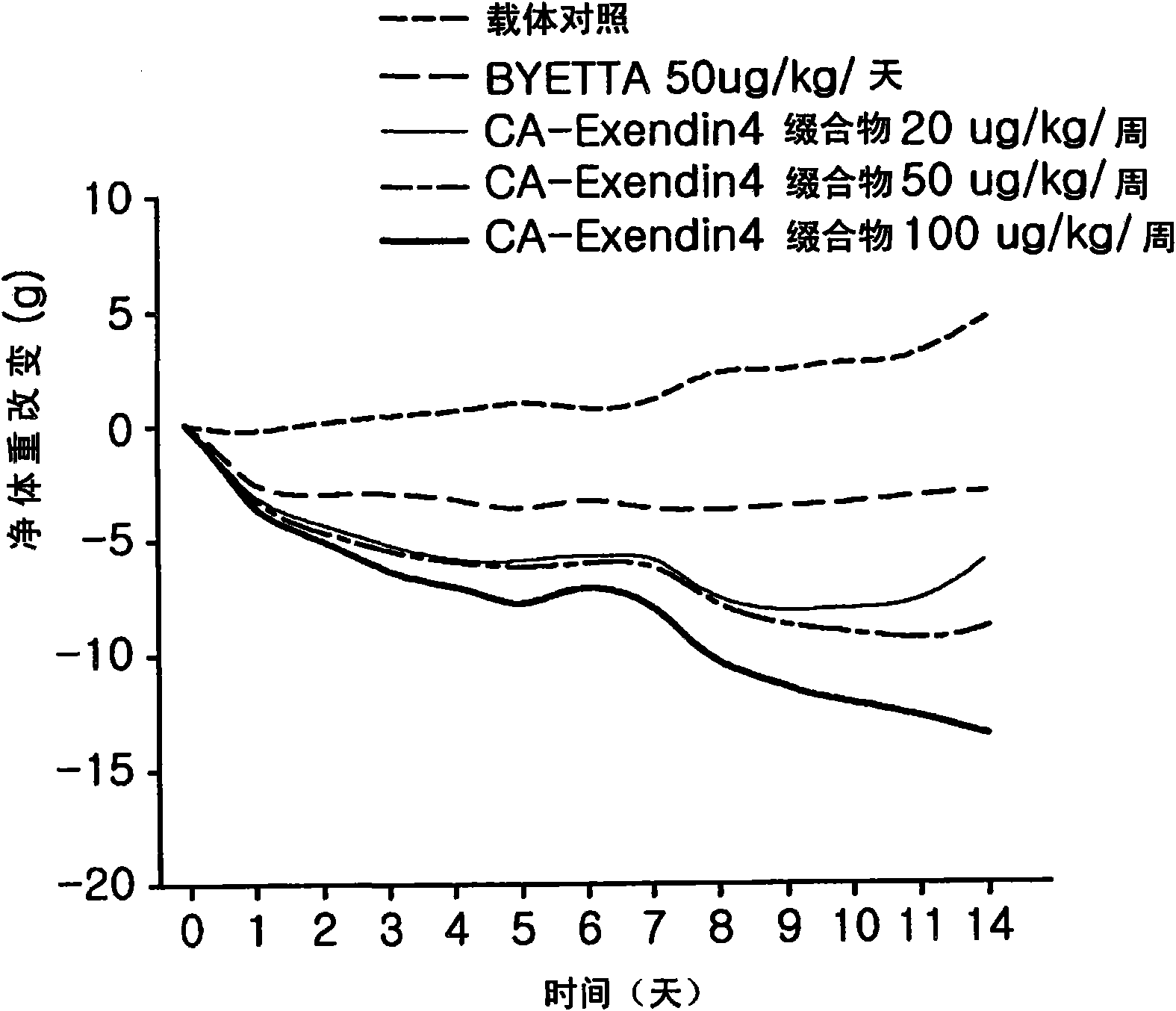A pharmaceutical composition for treating obesity-related disease comprising insulinotropic peptide conjugate
An insulin-stimulating and peptide-releasing technology, which is applied in drug combinations, active ingredients of artificially synthesized polymer materials, and metabolic diseases, can solve problems such as unrevealed efficacy and patient difficulties, and achieve the effects of inhibiting food intake and reducing body fat
- Summary
- Abstract
- Description
- Claims
- Application Information
AI Technical Summary
Problems solved by technology
Method used
Image
Examples
Embodiment 1
[0048] Example 1: Preparation of insulin-releasing peptide conjugate (CA-Exendin)
[0049] 3.4K PropionALD(2) PEG (PEG with two propionaldehyde groups, IDB Inc., Korea) and lysine residues of imidazo-acetyl Exendin-4 (Bachem, Swiss) were pegylated ( pegylation) by reacting the peptide with PEG at a molar ratio of 1:15 at 4°C overnight at a peptide concentration of 5 mg / ml. During this time, the reaction was carried out in a pH 7.5 buffer, to which 20 mM SCB (NaCNBH 3 ) for the reaction. Mono-PEGylated exendin and isomers were separated using SOURCE S (XK 16ml, Amersham Biosciences) under the following conditions.
[0050] Column: SOURCE S (XK 16ml, Amersham Biosciences)
[0051] Flow rate: 2.0ml / min
[0052] Gradient: A 0→100% 45 minutes B (A: 20mM citric acid pH 3.0; B: A+0.5MKCl)
[0053] The isolated mono-PEGylated CA-Exendin-4 was bound to immunoglobulin Fc. The reaction was carried out at a ratio of peptide:immunoglobulin Fc = 1:4 at 4°C for 16 hours wi...
Embodiment 2
[0060] Example 2: Weight loss effect of insulinotropic peptide conjugates in ob / ob mice
[0061] The well-known obesity animal model ob / ob mice (C57BL / 6JHamSlc-ob / bo, female, 8-9 weeks old) were divided into 4 groups (5 mice in each group), and then the vehicle and Byetta (Amylin- Lily, exendin-4, 45 μg / kg, subcutaneous injection every day) and the insulinotropic peptide conjugate prepared in Example 1 (45 μg or 100 μg / kg, subcutaneous injection once a week). Then, 28-day body weight changes were measured, and blood lipid metabolism parameters such as cholesterol and free fatty acid levels were measured after the administration was completed. After completion of the examination, the liver and adipose tissue were excised and weighed. The weight reducing effect of insulinotropic peptide conjugates in ob / ob mice is shown in Table 1.
[0062] Table 1
[0063]
[0064] as table 1 and figure 1 and figure 2As shown, the insulinotropic peptide conjugate showed the...
Embodiment 3
[0065] Example 3: Weight loss effect of insulinotropic peptide conjugates in DIO mice
[0066] The well-known obesity animal model DIO (diet-induced obesity) mouse mice (C57BL / 6NcrjBgi, male, 25 weeks old) were divided into 5 groups (5 mice per group), and then administered with vehicle and Byetta (100 μg / kg, injected subcutaneously every day) and the insulinotropic peptide conjugate prepared in Example 1 (20, 50, 100 μg / kg, injected subcutaneously once a week). Then, the body weight change in 2 weeks was measured. The body weight reducing effect of insulinotropic peptide conjugates in DIO mice is shown in Table 2.
[0067] Table 2
[0068]
[0069] as table 2 and image 3 As shown, the insulinotropic peptide conjugate showed a better weight loss effect than Byetta at 1 / 17.5 dose, and the effect was dose-dependent. In addition, weekly administration of the insulinotropic peptide conjugate maintains efficacy longer than daily administration of exendin-4.
PUM
 Login to View More
Login to View More Abstract
Description
Claims
Application Information
 Login to View More
Login to View More - R&D
- Intellectual Property
- Life Sciences
- Materials
- Tech Scout
- Unparalleled Data Quality
- Higher Quality Content
- 60% Fewer Hallucinations
Browse by: Latest US Patents, China's latest patents, Technical Efficacy Thesaurus, Application Domain, Technology Topic, Popular Technical Reports.
© 2025 PatSnap. All rights reserved.Legal|Privacy policy|Modern Slavery Act Transparency Statement|Sitemap|About US| Contact US: help@patsnap.com



